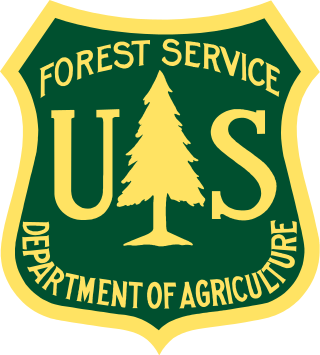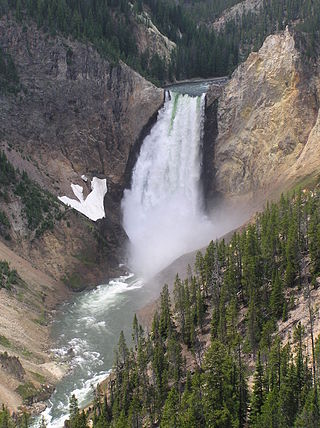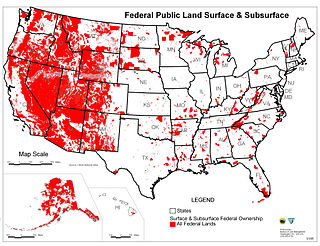Related Research Articles

The United States Forest Service (USFS) is an agency within the U.S. Department of Agriculture that administers the nation's 154 national forests and 20 national grasslands covering 193 million acres (780,000 km2) of land. The major divisions of the agency are the Chief's Office, National Forest System, State and Private Forestry, Business Operations, as well as Research and Development. The agency manages about 25% of federal lands and is the sole major national land management agency not part of the U.S. Department of the Interior.

The National Park Service (NPS) is an agency of the United States federal government, within the U.S. Department of the Interior. The service manages all national parks; most national monuments; and other natural, historical, and recreational properties, with various title designations. The United States Congress created the agency on August 25, 1916, through the National Park Service Organic Act. Its headquarters are in Washington, D.C., within the main headquarters of the Department of the Interior.
In all modern states, a portion of land is held by central or local governments. This is called public land, state land, or Crown land. The system of tenure of public land, and the terminology used, varies between countries. The following examples illustrate some of the range.

The protected areas of the United States are managed by an array of different federal, state, tribal and local level authorities and receive widely varying levels of protection. Some areas are managed as wilderness, while others are operated with acceptable commercial exploitation. As of 2022, the 42,826 protected areas covered 1,235,486 km2 (477,024 sq mi), or 13 percent of the land area of the United States. This is also one-tenth of the protected land area of the world. The U.S. also had a total of 871 National Marine Protected Areas, covering an additional 1,240,000 sq mi (3,200,000 km2), or 26 percent of the total marine area of the United States.

Federal lands are publicly owned lands in the United States managed by the federal government. Pursuant to the Property Clause of the United States Constitution, Congress has the power to retain, buy, sell, and regulate federal lands, such as by limiting cattle grazing on them. These powers have been recognized in a long series of United States Supreme Court decisions.

The National Natural Landmarks (NNL) Program recognizes and encourages the conservation of outstanding examples of the natural history of the United States. It is the only national natural areas program that identifies and recognizes the best examples of biological and geological features in both public and private ownership. The program was established on May 18, 1962, by United States Secretary of the Interior Stewart Udall.
The Charles M. Russell National Wildlife Refuge is a National Wildlife Refuge in the U.S. state of Montana on the Missouri River. The refuge surrounds Fort Peck Reservoir and is 915,814 acres (3,706.17 km2) in size. It is the second-largest National Wildlife Refuge in the lower 48 states of the United States, and the largest in Montana. Created in 1936, it was originally called the Fort Peck Game Range. It was renamed in 1963 after Montana artist Charles M. Russell, a famous painter of the American West. In 1976, the "range" was made a "refuge".

The National Wilderness Preservation System (NWPS) of the United States protects federally managed wilderness areas designated for preservation in their natural condition. Activity on formally designated wilderness areas is coordinated by the National Wilderness Preservation System. Wilderness areas are managed by four federal land management agencies: the National Park Service, the U.S. Forest Service, the U.S. Fish and Wildlife Service, and the Bureau of Land Management.

The Florida Trail is one of eleven National Scenic Trails in the United States. It currently runs 1,500 miles (2,400 km), from Big Cypress National Preserve to Fort Pickens at Gulf Islands National Seashore, Pensacola Beach. Also known as the Florida National Scenic Trail, the Florida Trail provides permanent non-motorized recreation opportunity for hiking and other compatible activities and is within an hour of most Floridians. The Florida National Scenic Trail is designated as a National Scenic Trail by the National Trails System Act of 1968.

The National Wildlife Refuge System in the United States has a long and distinguished history.
The Fish and Wildlife Coordination Act (FWCA) of the United States was enacted March 10, 1934 to protect fish and wildlife when federal actions result in the control or modification of a natural stream or body of water. The Act provides the basic authority for the involvement of the United States Fish and Wildlife Service (Service) in evaluating impacts to fish and wildlife from proposed water resource development projects.

According to the California Protected Areas Database (CPAD), in the state of California, United States, there are over 14,000 inventoried protected areas administered by public agencies and non-profits. In addition, there are private conservation areas and other easements. They include almost one-third of California's scenic coastline, including coastal wetlands, estuaries, beaches, and dune systems. The California State Parks system alone has 270 units and covers 1.3 million acres (5,300 km2), with over 280 miles (450 km) of coastline, 625 miles (1,006 km) of lake and river frontage, nearly 18,000 campsites, and 3,000 miles (5,000 km) of hiking, biking, and equestrian trails.

The Youth Conservation Corps(YCC) is a paid summer youth work program in federally managed lands. The National Park Service, US Forest Service, US Fish and Wildlife Service and Bureau of Land Management employ teens each summer to participate in the YCC. The YCC has introduced young Americans to conservation opportunities in public lands since the program was created in 1970. In the late seventies and early eighties the program included a grant-in-aid component that funded state and local YCC projects nationwide. This element fell to 1982 budget cuts, but several states continued the effort with their own funds. Some employees currently working in land management agencies were introduced to their profession through the YCC.
The Cooperative Funds Act is a United States law, or series of laws, which authorized the United States Forest Service (FS) to collect donations from private partners to perform FS work. Contributions had to be voluntary, and by cash, check, or money order only. It was also stipulated that there could be no conflict of interest between the donor and the FS.

The Consolidated Natural Resources Act of 2008 was an act passed in the 110th United States Congress and enacted on May 8, 2008.
American Frontiers: A Public Lands Journey was a non-profit publicity project executed from July to September 2002 which was intended to raise awareness about public lands in the United States. It involved teams of travelers making their way across the United States, from Mexico to Canada, traversing exclusively public lands and avoiding private estates.
Public Lands Interpretive Association (PLIA) is a cooperating association whose mission is to “inspire and educate the public about the natural and cultural heritage resources of America’s public lands.” PLIA operates https://www.publiclands.org where maps can be purchased and an interactive recreation map can be accessed to find public lands sites. PLIA provides those wanting to visit public lands with information and educational materials such as up-to-date fire news and alerts, and an online map center with Bureau of Land Management, Forest Service, and other maps helpful to users of public lands.
The America the Beautiful Pass series comprises annual or lifetime passes that grant the holder entrance to more than 2,000 federally protected areas including national parks, national monuments, and other protected areas managed by six federal agencies: the National Park Service, the Forest Service, the Fish and Wildlife Service, the Bureau of Land Management, the Bureau of Reclamation, and the Army Corps of Engineers. At per-vehicle fee areas, the pass entitles the holder and all passengers in a non-commercial vehicle to admission. At per-person fee areas, the pass entitles the holder and up to three additional adults to admission. The pass was created by the Federal Lands Recreation Enhancement Act and authorized by Congress in December 2004, which is Division J, Title VIII of the Consolidated Appropriations Act, 2005, Public Law 108–447, 118 Stat. 2809, an omnibus appropriations act. Passes are available at all National Park Service sites that charge entrance fees as well as online through the United States Geological Survey online store. The passes have been described as one of the best deals in recreation.
References
- ↑ What is a Cooperating Association?
- ↑ Why is the Yosemite Museum Special?
- ↑ National Park Service Cooperating Associations
- ↑ "Bureau of Land Management Cooperating Associations". Archived from the original on 2011-06-15. Retrieved 2010-10-19.
- ↑ US Army Corps